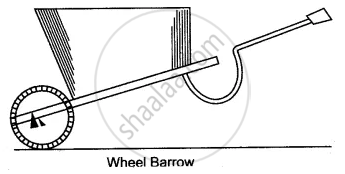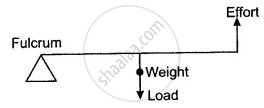Advertisements
Advertisements
Question
Draw a diagram of a lever which is always used as a force multiplier. How is the effort arm related to the load arm in such a lever?
Solution
Because the effort arm of a Class II lever is longer than the load arm and the mechanical advantage is always greater than 1, the lever multiplies force.

APPEARS IN
RELATED QUESTIONS
State the principle of a lever?
Write down a relation expressing the mechanical advantage of a lever.
Give one example of a class I lever where mechanical advantage is more than one ?
Fig 3.17 below shows a lever in use.

(a) To which class of lever does it belong?
(b) If FA = 80 cm, AB = 20 cm, find its mechanical advantage.
(c) Calculate the value of E.
Give three examples for leavers of 1st order.
The following belong to which class of lever?
Pliers Tools
The following are an example of levers. State the class of lever to which each one belongs giving the relative positions of Load (L), Effort (E), Fulcrum (F):
(i) Scissors (ii) Sugar tongs (iii) Nutcracker (iv) Pliers.
In the following diagram of a wheelbarrow, mark the fulcrum (F) and indicate the directions of load (L) and effort (E) with arrows.

What class of lever is it? Give one more example of the same class of lever.
When we want to use a machine as a force multiplier, which class of lever should we preferably use? Give a simple diagram of such a lever.

A lever is used to multiply the force.
